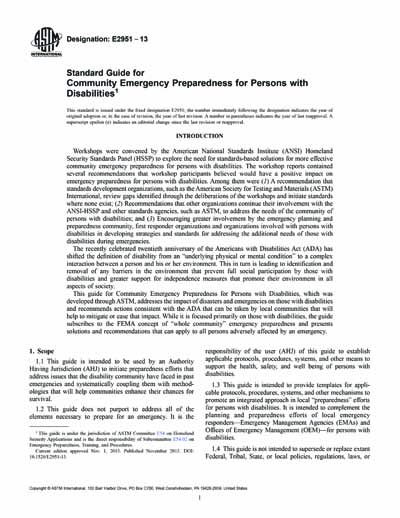Historical
ASTM E2951-13
Standard Guide for Community Emergency Preparedness for Persons with Disabilities
1.1 This guide is intended to be used by an Authority Having Jurisdiction (AHJ) to initiate preparedness efforts that address issues that the disability community have faced in past emergencies and systematically coupling them with methodologies that will help communities enhance their chances for survival.
1.2 This guide does not purport to address all of the elements necessary to prepare for an emergency. It is the responsibility of the user (AHJ) of this guide to establish applicable protocols, procedures, systems, and other means to support the health, safety, and well being of persons with disabilities.
1.3 This guide is intended to provide templates for applicable protocols, procedures, systems, and other mechanisms to promote an integrated approach in local “preparedness” efforts for persons with disabilities. It is intended to complement the planning and preparedness efforts of local emergency responders—Emergency Management Agencies (EMAs) and Offices of Emergency Management (OEM)—for persons with disabilities.
1.4 This guide is not intended to supersede or replace extant Federal, Tribal, State, or local policies, regulations, laws, or criteria, or standards and guides produced by any other entity, such as the National Fire Protection Association (NFPA).
1.5 This guide is intended for an AHJ, whether a governmental agency, non-profit, private organization, or other entity involved in the preparedness planning for persons with disabilities.
1.6 This guide recognizes that the ADA addresses all services and facilities pertinent to the access and care of persons with disabilities, including those associated with emergencies. It also recognizes that the Stafford Act and Post Katrina Emergency Management Reform Act, along with Federal, State, and Local Civil Rights Laws, mandate integration, inclusion, coordination, and non-segregation for people with disabilities in emergency programs, services, and activities.
1.7 This guide is intended to assist those involved in emergency preparedness for persons with disabilities in order to help them better understand the concepts of accessibility and equal opportunity in such important areas as alert and notification, evacuation, shelter management, etc., before, during, and after an event.
1.8 This standard does not purport to address all of the safety concerns, if any, associated with its use. It is the responsibility of the user of this standard to establish appropriate safety and health practices and determine the applicability of regulatory limitations prior to use.
Content Provider
ASTM International [astm]






